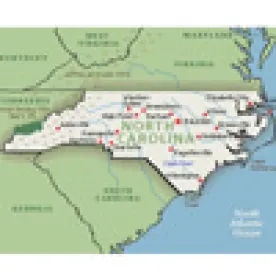North Carolina’s nascent biogas industry has witnessed significant progress in recent years. In March 2018, the Optima KV swine waste to renewable natural gas (“RNG”) project near Kenansville, North Carolina came online as the first RNG project in the state to inject RNG directly into the existing natural gas transportation system operated by Piedmont Natural Gas Company, Inc. (“Piedmont”). With the success of the Optima KV project, other RNG projects are in process and more are sure to follow in light of North Carolina’s rich bioenergy resources. However, not long after the Optima KV project achieved commercial operation, the North Carolina Utilities Commission (the “Commission”) put the brakes on future development. RNG project developers and suppliers will now need to be accepted into a pilot program established by the Commission in order to be approved to interconnect with Piedmont’s existing natural gas transportation system.
In June 2018, the Commission approved a modified version of Piedmont’s proposed Appendix F to its Service Regulations as a pilot program (the “Pilot Program”) for a three year period, 1 setting forth the terms and conditions under which Piedmont may accept and receive Alternative Gas2 onto its system and deliver such gas to its customers. In light of the Commission’s charge to ensure that Piedmont provides adequate, reliable and economical service to its customers, the Commission established the Pilot Program as a means to address concerns of potential service quality and operational issues that may arise from the injection into and delivery of Alternative Gas on Piedmont’s system. Through the Pilot Program, the Commission seeks to gain information from Piedmont regarding the impact of Alternative Gas on its system operations and its customers before permitting a proliferation of projects throughout the state.
To be accepted into the Pilot Program, an Alternative Gas supplier will need to demonstrate to the Commission that “such additions will be useful in gathering the information and data sought by the Commission.”3 Unfortunately, only sparse guidance was made available to potential Pilot Program applicants as to what specific information should be included in an application to participate in the Pilot Program in order to demonstrate usefulness in gathering the information and data sought by the Commission.
Two Alternative Gas projects were automatically admitted to the Pilot Program at its creation (the Optima KV project and the C2e Renewables NC (“C2e”) project). To date, four applications to participate in the Pilot Program have been filed with the Commission. A review of these four applications helps shed light on the project characteristics that the applicants believe may be “useful in gathering information and data sought by the Commission.” The reasons raised in support of the proposed Alternative Gas projects for the Pilot Program include the following:
- The location of the project’s interconnection point on Piedmont’s pipeline in relation to existing Piedmont customers.
- The number and proposed locations of proposed interconnection injection points within the state.
- The extent to which the Alternative Gas at the interconnection point will be diluted or mixed with fossil-derived natural gas.
- The type of feedstock used in the Alternative Gas production process, differentiating that feedstock from that of other applied-for projects (i.e., highlighting alternative feedstocks). Feedstocks involved in Alternative Gas projects for which applications have been filed include animal wastes (swine and poultry), green agricultural wastes, food processing facility wastes, and municipal solid waste
- The extent to which the characteristics of Alternative Gas produced by one project will vary as compared to other applied-for projects
- The degree to which the applied-for project has advanced with feedstock suppliers, gas purchasers, Piedmont and other stakeholders such that the time to commercial operation of the project will be sooner, and thus capable of providing useful information to the Commission during the early portion of the Pilot Program.
Public policy arguments in favor of including particular projects in the Pilot Program have been put forth by applicants as well. These arguments generally fall into the following three categories:
- That the project will aid electric utilities (the putative Alternative Gas purchasers) in meeting North Carolina’s Renewable Energy and Energy Efficiency Portfolio Standards
- That the project will result in additional economic development in the predominantly rural counties of the state in which the project will be constructed (almost all of which are classified as Tier 1 counties by the North Carolina Department of Commerce).
- That the project has incurred considerable time, energy, and resources in the course of its development and further delay would be financially detrimental to the project’s stakeholders.
Of the four applications submitted to the Pilot Program, the Commission has approved only one: the Optima TH RNG project adjacent to Smithfield Foods’ hog processing facility in Tar Heel, North Carolina. In its order approving the Optima TH application, the Commission found persuasive the difference in feedstock used by the Optima TH project (food processing facility wastes) as compared to the Optima KV and C2e projects that were originally admitted into the Pilot Program.
1 See Order Approving Appendix F and Establishing Pilot Program in Commission Docket No. G-9, Sub 698 issued on June 19, 2018 (the “Order”), page 5.
2 “Alternative Gas” is defined in Appendix F as “gas capable of combustion in customer appliances or facilities which is similar in heat content and chemical characteristics to natural gas produced from traditional underground well sources and which is intended to act as a substitute or replacement for Natural Gas (as that term is defined in Piedmont’s North Carolina Service Regulations. Alternative Gas shall include but not be limited to biogas, biomethane, and landfill gas, as well as any other type of natural gas equivalent produced or manufactured from sources other than traditional underground well sources.” Order, Footnote 1



 />i
/>i

